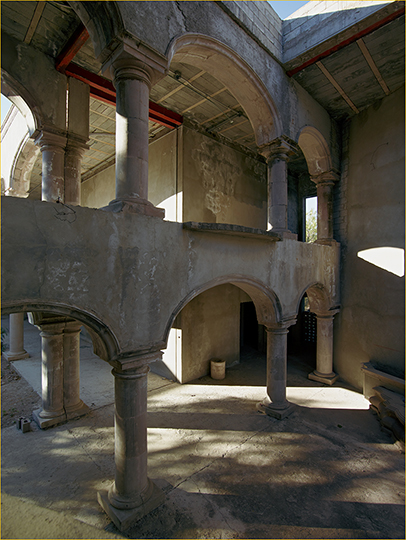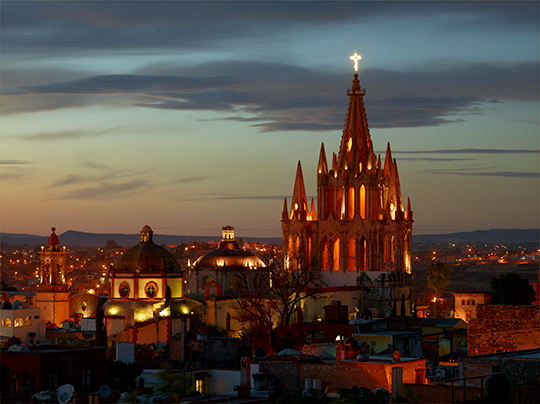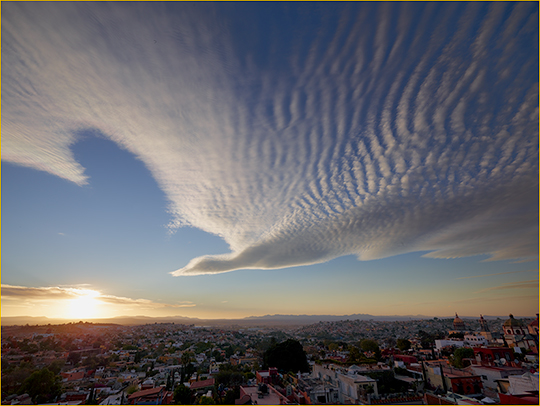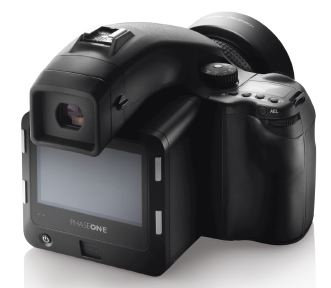Abandoned Hotel. San Miguel de Allende, Mexico. January, 2011
Phase One DF with IQ180 back and 28mm lens @ ISO 50
A lot of coverage, I know, and some would guess at an ulterior motive. They’d be wrong. It’s just that both Leaf and Phase One know how to play the PR game. They have put on a blitz on the media, with personal visits, demos, test loaners, and as a consequence they get coverage, not only here but on a great many other sites and in print media.
If your favorite camera company isn’t getting coverage here, maybe it’s because they’re not asking for it. Among the major players Canon, Sony, andPanasonic are all proactive, providing access to pre-production cameras and review samples. Some other companies, not so much. Their loss.
IQ180
There has been a buzz in the industry about an upcoming 80 Megapixel medium format sensor for about a year now. When Leaf announced theirAptus II 12at Photokina in September, 2010 it didn’t take a genius to figure out that Phase One (Leaf’s new parent company) would have one soon as well. The question on most people’s minds was –why the delay?
The answer came in late January with the announcement of the IQ180, as well as two other backs, the IQ160 and and IQ140, with 60 Megapixel and 40 Megapixel sensors respectively. We’ll be discussing the 80MP IQ180 here, but other than the sensor the other backs are essentially identical to the IQ180.
This is not just a new back, or family of backs. It’s a major step forward in medium format technology. Starting with what was a blank engineering slate Phase One has taken virtually every aspect of medium format back design and put it under the microscope.
The results is a back that appears to address virtually every complaint that I and other MF users have had with previous backs. Let’s look at these in turn.
The sections below are derived from my initial product announcement report, but elaborated based on my experience shooting with a pre-production back. Not all features are fully implemented, and therefore there may be nothing much more to say about them until production backs ship.
Oh yes – based on my two days of working with a pre-production IQ180, I’ve decided to upgrade from my P65+. My wallet said not to but my heart said go for it. I expect to publish a follow-up test report once a production back is available and I’ve had some field experience with it, likely in May.
What’s New?
The Sensor
The IQ180’s sensor is 80MP, trumping the 60MP sensors used in previous backs from Phase as well as other companies. This sensor is similar to the one in the Aptus II 12, but it has Sensor+ capability and some proprietary Phase One “secret sauce“.
If you readmy Aptus reviewyou’ll know that the jump from 60MP to 80MP surprised me. I had expected a moderate improvement in apparent resolution but after a few hundred frames, first with the Aptus and then with the IQ180, I can say that it is more than a “moderate” improvement. It’s actually quite noticeable.
I caution that this and other comments are based on a pre-production back and so no hard conclusions should be drawn. But in discussions with Mark Dubovoy, who has also tested the same sample back, what we are seeing is also lower noise over the P65+ (even at ISO 50) and a slight but discernible increase in DR.
Parroquia Sunset, San Miguel de Allende, Mexico. January, 2011
Phase One DF with IQ180 back and 150mm lens @ ISO 50 8 seconds @ f/8
The shot above, of the famous San Miguel Parroquia, was taken at dusk, with the specs given above. Below is a 100% enlargement. Note that I have deliberately somewhat over-sharpened this file for web display. A print would have more subtile sharpening.
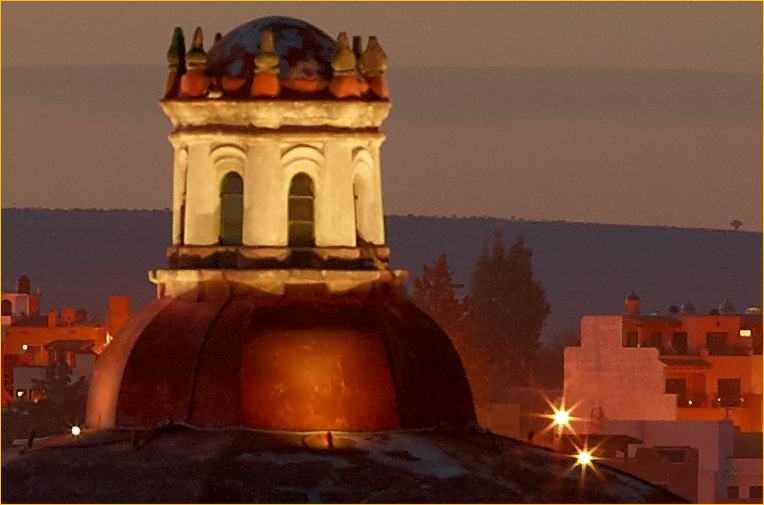
This image answers the questions –How is it with longish exposures?–What’s the resolution like?–How’s the dynamic range?–Are the Phase / Mamiya lenses any good?– and so on.
Print Sizes
Here’s the deal. If you aren’t making really large prints, or shooting commercially for an ultra-exacting client, an 80MP back is likely overkill. If you like the IQ series back’s features (and what’s not to like?), then the 60MP IQ160 and even the 40MP IQ140 will more than do the job.
So – let’s have a look at what an 80MP file gives you, becauseneedandwantdon’t necessarily have to go hand in hand.
Showing up in Photoshop after export from C1 as a 480 Megabyte 16 bit TIFF (here’s your excuse to buy that 12 Core, 12 GB Mac Pro you’ve been wanting), an IQ180 file can make a 20X27″ print at 360PPI from its 10,338 X 7760 pixels. Drop to 300PPI and you can make a 25X33″ print. At 180PPI a 41X55″ print is possible.
In other words, without ressing up you can make prints as large as most normal human beings ever need or want.
And of course if you’re doing landscape fine art work and want to stitch a few frames together (and give that new Mac Pro a real workout) you can make billboard sized prints that will stand nose-to-paper scrutiny. Nothing short of a scanning back has ever provided us with comparable image quality.
Of course you don’thave tomake humongous prints to enjoy what an IQ180 can offer. Just as with shooting 8X10″ film where one can make contact prints that have that special ultra-high-res look, so too is this the case when making an A3 print off a half gigabyte file from an 80Mp back like the IQ180.
IQ180 or 8X10″
OK. I’m going to be a bit provocative here. Back in 2004, when the Phase One P45 first came out, in my opus titledMeasuring Megabytes, several highly experienced large format fine art photographers agreed, after exhaustive testing, that the 39 Megapixel Phase One P45 back more or less equaled drum scanned 4X5″ film. This wasn’t a surprise to many of us, as we’d seen this coming for some time.
After now using a P65+ for a couple of years there’s no question that it exceeds 4X5″ film in resolution, dynamic range and colour fidelity. So, what about the 80 Megapixel IQ180? Should it have been called the IQ8X10? Is an 80 Megapixel 500 Megabyte file able to equal 8X10″ film?
I don’t know. My seat-of-the-pants guess would be – yes. So, here’s my challenge. If there’s anyone out there that is still shooting 8X10″ film, drum scanned or printed in the chemical darkroom, and who would like to do a side-by-side shoot out,please let me know, and when the IQ180 is shipping in May let’s get together and find out.
Large Hi-Res Touch Screen
The most obvious new feature is the large (3.2″) 1.15 Megapixel retina style touch screen (similar to that on the iPhone 4). It has 290 ppi, 16 million colors, and a 170º viewing angle.
The screen has advanced touch controls, including zooming, swiping, and similar touch screen controls. For those that don’t care to use a touch screen the IQ backs retain Phase One’s intuitive four button controls.
The screen turns out to be quite impressive. Compared to working with a P series back it’s like looking at a decent sized HD TV screen vs. a small dimly lit SD TV. I am told that the automatic screen brightness function on the sample that I had was not yet functional. I hope that eventually screen brightness is improved, because while adequate, and far superior to my P65+, it isn’t in iPhone territory yet when it comes to daylight visibility.
Touch functions are very well executed. Double tapping and swiping are smooth and almost instant. There are no excuses needed for any aspect of this screen’s touch performance. In fact the speed of screen activity is startling. Swiping thumbnails is instantaneous and double tapping to go to 100% as quick as one could want. Faster in fact that going to 100% in Capture One 6.1 on a 3Ghz Mac Pro.
The screen interface is well laid out. In one configuration you can have a review image center left, a histogram top right and a highlight warning mini-thumbnail bottom right. Tapping the thumbnail swaps to the larger left image and tapping the histogram makes it center screen. Very, very, nice.
The high resolution screen also makes 1:1 magnification meaningful, and sharpness and resolution can be fairly accurately judged, a first in my opinion for an MF back, and certainly for a Phase One back.
Pending more than a couple of days of use I have to give Phase an A+ for the new screen technology.
As good as the touch screen is, and it’s very good, there are times when one wants buttons. Outdoors in winter when wearing gloves, for example. Fortunately Phase has decided to include its traditional modal four button P back design. After a brief familiarization it’s a very intuitive interface, and by combining the old and the new Phase One has, to my mind, done absolutely the right thing.
In Flight, San Miguel de Allende, Mexico. January, 2011
Phase One DF with IQ180 back and 28mm lens @ ISO 50
Focus Mask
Of particular interest is that the new backs provide a Focus Mask confirmation tool, similar to that found in Capture One 6. This means that exact focus confirmation as well as depth of field can be reviewed on-screen. If this was all that was offered the new backs would be exciting enough, but we have been told that when the backs ship beginning in April they will feature a form of Live View.
The Focus Mask function was not operational on the pre-production back which I tested therefore no additional comments can be made at this time.
A Form of Live View
Because the IQ backs use CCD sensors, as do the current P+ series, they are not capable of fast-refresh Live View. But, Phase One’s engineers look like they will be able to pull a rabbit out of a hat and provide Live View with a slow refresh rate. It remains to be seen how effective this is, but if it works as promised it will be the holy grail for MF shooters, especially those that use technical cameras, since ground glass focusing and framing will no longer be necessary.
The Live View function was not operational on the pre-production back which I tested, therefore no additional comments can be made at this time.
Battery and Weather Sealing
Along with the new industrial design and large high-resolution touch screen the IQ backs now enclose the battery within the back. (The same battery as in P backs is used). This enclosure along with tighter weather sealing and port covers will likely mean that location and outdoor photographers will benefit.
The only opening without weather sealing is the CF card door, but I’ve been told this will be added before production begins.
The die cast aluminum chassis has the usual all-of-a-piece feel to it, and in all likelihood an elephant could stand on it, just as with the previous generation P backs.
Firewire 800 / USB3, and Sensor Plus
In addition to the familiar Firewire 800 connector the IQ backs are the first cameras that I’m aware of to feature USB 3 as well. Indeed the backs support USB 2, USB 3, Firewire 400 and Firewire 800.
The back has a built-in charger that charges the battery continuously whenever the back is connected to a computer via either FireWire 800 or USB (including USB 3). Folks who do long shoots in tethered mode, such as fashion and product photographers, no longer have to worry about battery replacement during a shoot.
And like the P+ series backs all IQ backs feature Sensor Plus technology, which means that they can shoot at a reduced pixel count with increased sensitivity and faster frame rates. In the case of the IQ180 resolution is reduced to 20 Megapixels while write speed is increased. ISOs up 3200 are available in 20MP mode. At 80MP it is 1 frame every 1.4 seconds, while at 20MP it’s 1 frame every 1.1 seconds.
The IQ180 has a 1.5 Gigabyte buffer of high speed RAM.
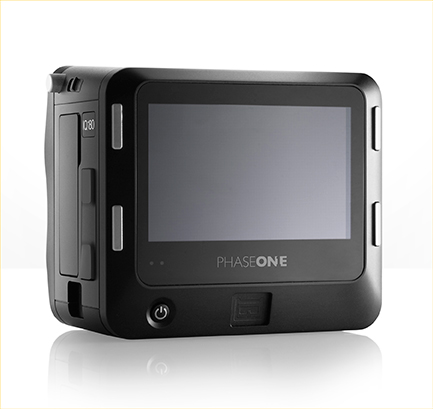
As soon as I have a production IQ180 I will test tethering with USB3 (assuming that I can find a computer with a USB 3 port to test it with).
ISO, Noise, & Dynamic Range
Phase One is claiming a dynamic range of 12.5 stops, between a third and a half stop better than the P65+, their best previous back. They also are claiming that the IQ180 is the lowest noise back yet, even though the pixel pitch has been reduced to 5.2 microns to achieve 80MP.
The ISO range on the sensor is between 50 and 800, while, as already mentioned, in Sensor+ mode sensitivity goes up to ISO 3200.
I did not test Sensor+ on this back, but will do so when I have a production back for testing.
As for DR and noise, as mentioned earlier on the pre-production back at least we are seeing lower noise over the P65+ (even at ISO 50) and a slight but discernible increase in DR.
The IQ series backs are available in mounts for Hasselblad V, Phase One and Mamiya DF bodies, and Contax bodies, as well as a broad range of technical cameras with any of these mounts. I have also learned that Phase will be making and selling IQ backs in Hasselblad H1 and H2 mounts, so the tens of thousands of earlier H series owners will be able to avail themselves of the new 80MP and IQ technologies.
Camera Interface
Current owners will be pleased to learn that the back’s electrical and physical interface remains the same, so the new IQ backs will work on any previous compatible camera. But the interface has been enhanced so that with Phase One 645DF bodies the camera can turn the back on and off, rather than one having to do so separately. An independent power switch remains on the back for when it’s used on a technical camera.
It should be said that Phase One has made clear that this back is designed for the future, which obviously means updates to their current camera line as well as potential new cameras in future. Of course we can only conjecture what these capabilities might be, but the IQ backs are clearly equipped to handle future interfaces, whatever they might be. Whether P series backs will be able to be similarly updated is unknown at this time. While P backs remain in the line as a lower-priced option it would be a reasonable guess that eventually IQ backs will become Phase’s primary product line and the one that they build their next camera line on.
Maximum Exposure Time
Maximum exposure time on the IQ backs remains at 1 minute. It’s been explained to me that the Dalsa chips that Phase now uses are limited in this way, with the trade-off being their Sensor+ capability. Previous non-Plus series backs used Kodak chips that allowed very long exposure times. I once did a noiseless 45 minutes exposure with a P45.
Auto Alignment
The new back has sensors that can tell whether the back is level from side to side and from front to back. The user can use this capability to level the camera while shooting, or select a preference in the latest version of CaptureOne so that the software automatically levels the image in either direction or both.
These alignment sensors were not operational in the pre-production back that I used.
Capture One 6.1
Simultaneous with the announcement of the IQ backs was the release of Capture One 6.1. I had not looked at C1 6 when it came out some months ago, with my only excuse being that I was shooting primarily with new cameras that C1 doesn’t support, using Lightroom 3 in its stead, and therefore hadn’t familiarized myself with its new features.
When Kevin loaded 6.1 on my Macbook Pro and spent an hour or so familiarizing me with the new features of V6 I was knocked out. As I wrote in my recent Aptus report, Capture One appears to have closed most if not all of the gap between itself and Lightroom 3 in terms of features. Local adjustments with layers, perspective control, editing of JPGs and TIFFs, and more, make it a real powerhouse.
I have always regarded C1 as the “gold standard” in raw image processing, and now that it is competitive with LR3 in terms of features it’s once again becoming my favourite raw editing software. Of course if you’re buying an IQ back C1 will likely be the only program that can handle its files for some time to come, and of course each IQ back comes with a free copy.
Capture One is still a resource hog, and you’ll need a powerful machine to make it fly, but then you’re going to need a high powered computer to work with the IQ180’s 480MB files. (That’s when converted to TIF. In raw, out of the camera, they are a mere +/- 80MB).
Hand-Held Folly
This section is the same as the one for theAptus II 12, because the same experience applies.
The first thing I saw when loading the files into Capture One 6.1 was a confirmation in spades of what I had learned when first working with my Phase One P65+. These high resolution backs are unforgiving of anything less that perfect shooting technique. A hand-held shutter speed that would be fine with a DSLR or even a 30ish Megapixel back just doesn’t deliver with sensors of ultra-high resolution.
It is folly to shoot hand-held at anything less than 2X the reciprocal of the focal length, and frankly I’d shoot at 3X to be sure of getting decent quality. So, an 80mm lens needs at least a shutter speed of 1/250 sec (80X3). Even then you’ll be better off shooting from a tripod, or with electronic flash in the studio if you’re working hand-held.
Red Shadows
The only anomaly that I’ve noted in terms of image quality with the IQ 180 as well as the Aptus II 12 is a tendency toward a reddish cast in deep shadows. The word from Phase One is that the camera profile is not yet finalized.
In the meantime a Custom Style with the red channel Curve lowered slightly in the quarter tones, cleans things up reasonably well.
That’s Amoire
Most medium format backs, and all backs from Phase One, do not have AA filters. This is a significant contributor to their higher resolving power than DSLRs, which almost universally do have one. But, of course, without an AA filter moire can be an issue.
The techie types tell us that as pixel pitch decreases, so does the chance for moire. There simply aren’t patterns in fabrics that are that fine as to create interference patterns with the sensor’s pixel grid.
That certainly seems to be the case with the IQ180. Try as I might, with fabrics, tile roofs, and mesh satellite dishes at various distances I could not see a single case of moire. Maybe the techies are right. Once the pixel pitch is fine enough in relationship to the magnification factor moire ceases being a factor, even without an AA filter.
I’m sure that someone will be able to make a shot with an IQ180 showing moire, but unlike with lower resolution backs I think it will be the exception.
For Current Back Owners
If you’re a current Phase back owner and are looking towards an upgrade I’ve been told that Phase One has a special offer during Q1, 2011. You can get a trade-in value of the same as your back’s model number. So a P45+ is worth a 45% discount as a trade in, and a P65+ is worth a 65% discount as a trade in.
For owners of non-Phase backs you can get a trade-in allowance toward an IQ180 of a percentage equal to your back’s megapixel count. So, a 39MP back gets a 39% discount. I assume that the same thing applies to non-Plus series P backs.
Finally, Phase has a program during Q1 (till the end of March) that will provide you with a P65+ right away if you order an IQ180, and then for the increment in price the IQ180 swapped for the P65+ once the IQs start shipping.
My advice is that if any of this interests you to contact your local Phase dealer. Don’t ask me – I just report this stuff.
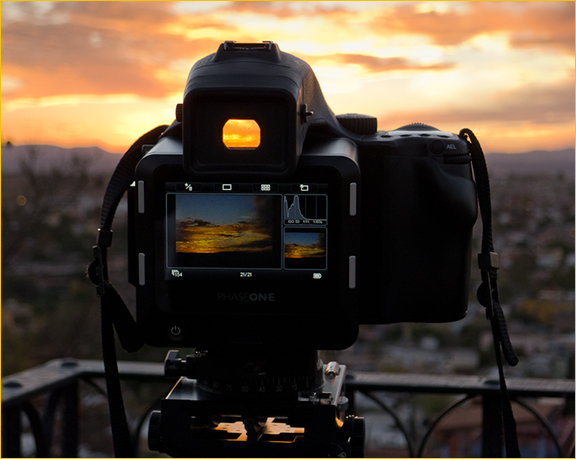
The Verdict
The IQ series of backs are clearly a generational leap in medium format technology. In the week or so following introduction I’ve spoken with several executives in the camera industry and all are agreed (even competitors) that Phase appears to have done an outstanding job with bringing these new backs to reality. The IQ backs pretty much answer the feature requests that most photographers have voiced, and who can quibble with 80MP resolution?
Of course price (US $44,000) is an issue (it always is). But the IQ180 is priced no differently than the P65+ was a few years ago when it first came out, and in every way it is a far superior product.
For many wealthy amateurs and successful fine art photographers price will not be an issue. There are people who buy a new BMW 7 series or Mercedes S series every couple of years, whether they need it or not, and so why not do the same to have a state-of-the-art back as well?
There will also be many pros working for demanding high-end clients who will be able to justify the expense. This is simply another business tool. For some their accountants will tell them at the end of their fiscal year that they need to buy some new gear, or alternately, send the money to the tax man. Which would you prefer if you were asked that question?
For most other photographers backs in this price range are like Ferraris – fun to read about, fun to dream about, but they’re unlikely to appear under the Christmas tree this year. But whichever camp one belongs in, it’s nice to know that medium format technology is alive and well and that the advancement that the IQ180 and its sisters represents will soon be available to us.
Does the IQ180 deliver the goods? The final answer will have to await a full field test of a production back some time in May. What we see now in terms of features is compelling, and image quality is astonishing, but there are still important features which have only been described and not yet seen, such as the Focus Mask and Live View. I can hardly wait to try them out.
February, 2011
